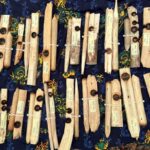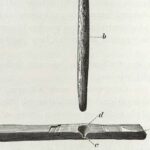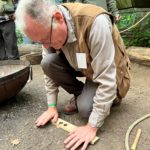At the Global Bushcraft Symposium 2022 in the UK, Gordon Dedman presented the hand drill friction fire lighting method he teaches in Australia. As most readers of this topic will know the basic techniques of hand drill friction fire lighting, I will only concentrate on specific aspects of this technique as taught by Gordon.
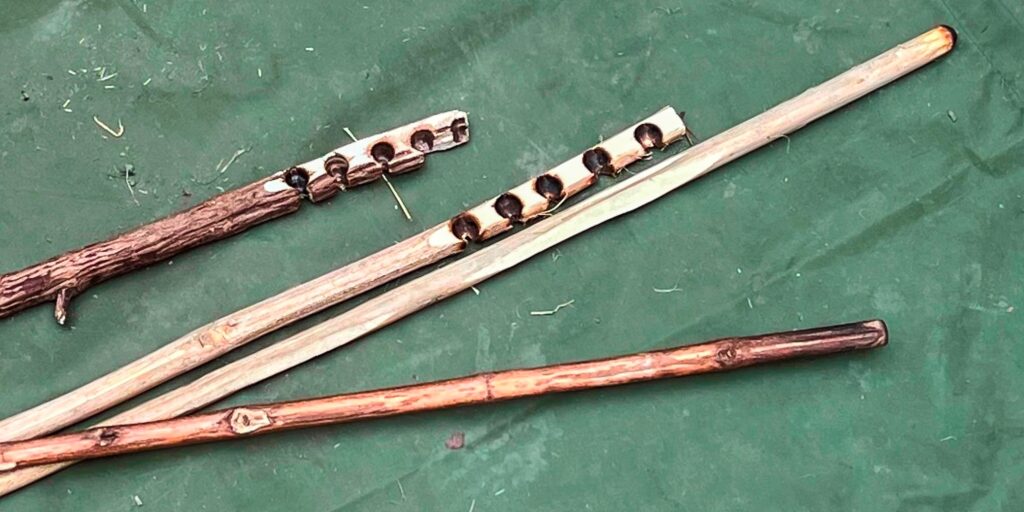
Setting up the hand drill set
In this article, we already discussed recommended wood species for hand drills in Australia. Here, I will only discuss the shapes and procedures of hand drill fire lighting. As can be seen, the whole equipment set-up of a hand drill set is by far simpler compared to a bow drill set. We just got the hearth board, spindle, and ember catch.
Hearth Board
The hearth board is just a bit wider than the spindle, and both are often from the same shrub, bush, or tree. The hearth board stick has three flat sides: two flats on top and bottom each and one sidewall perpendicular to them.
Spindle

The spindle length (besides the wood species) is the most significant difference between using a hand drill in Australia and in most African countries. An Australian spindle is about 1 m long, whereas, in most African countries, it is not more than about 40 cm in length. This difference is due to different body positions taken when drilling with hands. The only exception is the Hadzabe people in Tanzania, using an exceptionally long spindle for hand drilling.
.
.
.
.
.
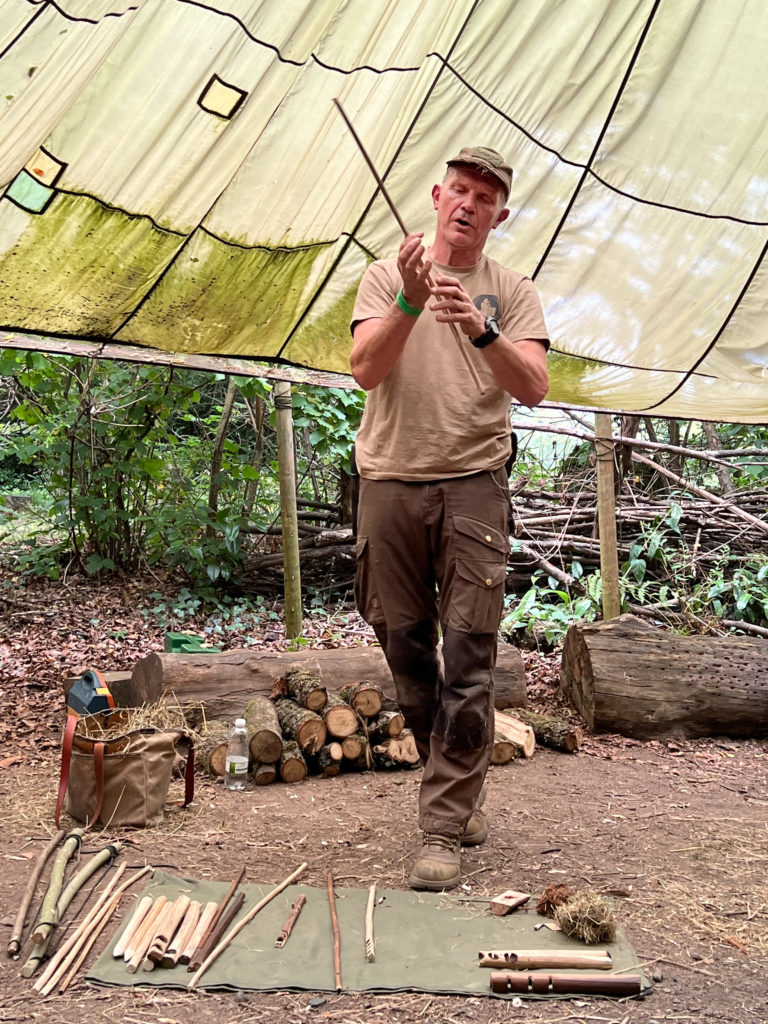
A typical hand drilling position in Australia is sitting on the ground. One leg stretches out, and one leg holds the hearth board sideward with the opposite foot. The twisting of the spindle starts at a position of eye height, and the twisting palms move down to stomach height. Hold the spindle into the contact area and move with the hands up again. The spindle portion from stomach height downwards is just used to transfer movements and forces.
The typical hand drill position in African countries does not involve stretched-out legs; both legs are angled, allowing the upper body to move further down to the ground.
.

These long Australian hand drill spindles must be straight, as they swirl around when twisted. And such long and straight shoots are not easy to find. Therefore, such spindles often have to be straightened over a fire. With ‘wetting, heating up, bending,’ straight spindles can be produced relatively quickly. The best thickness of hand drill spindles is about the middle finger’s thickness.
Burning in the hand drill set and notching
As the contact area of hand drills is smaller than that of bow drill setups, friction and heat are setting in relatively fast. Notch cutting is done more efficiently than bow drills, as there is far less wood to remove.
Producing ember with the hand drill and turning into fire
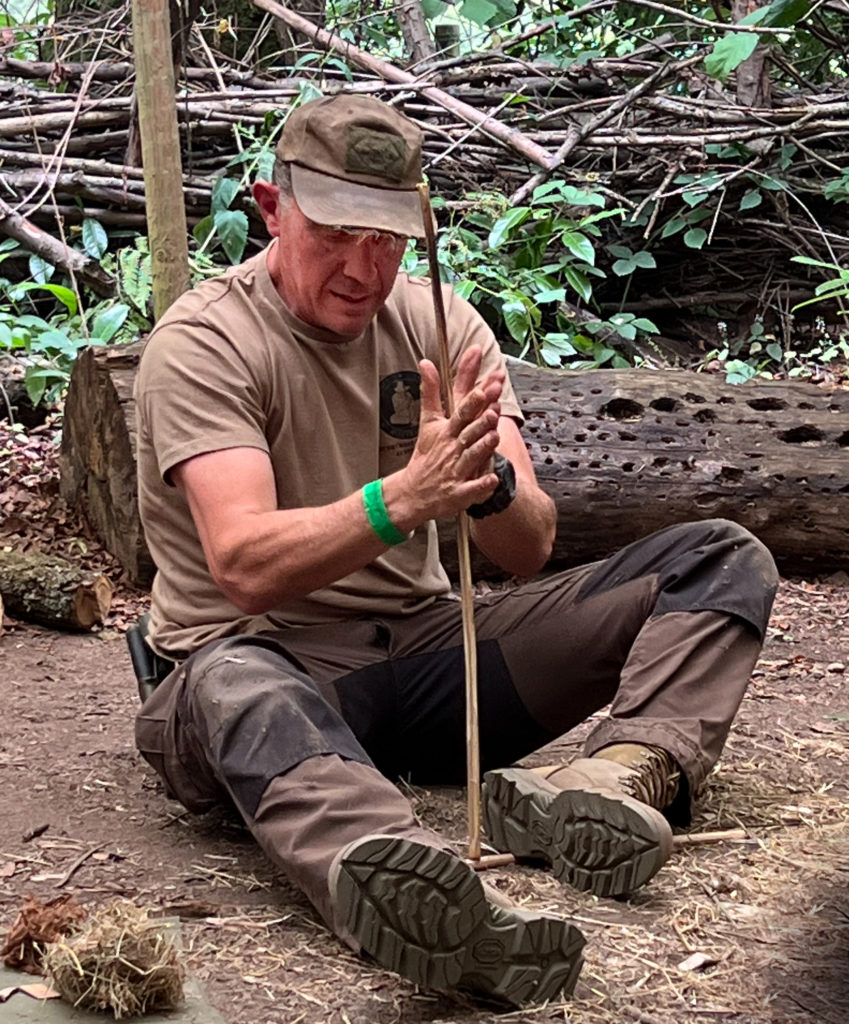
When having a good, paired set of hand drills, it takes about the same time as for bow drills to produce an ember. Again, at the last 10 seconds, the spindle should be twisted vigorously. Depending on the smoothness of the spindle wood to be used, a certain amount of calluses on the inner palms of the hands is a bonus. Embers of hand drills are smaller than their bow drill cousins, but they usually hold for about 1-2 minutes after setting. Transferring the ember into a processed grass bundle with additional fluffy tinder and gentle, long-lasting blows will produce flames.

Lessons learned from Gordon about hand drill fire lighting
- Sitting with the stretched legs on the ground is a convenient hand drill position
- Hand drill spindles in Australia are often bent over fire
- Calluses on the palms of the hands are an advantage for hand drilling and processing of grass bundles
Global Bushcraft Symposium 2022 (GBS2022) and Gordon Dedman
GBS2022 was held from 27th-31st July 2022 at Llyn Tegid (Bala Lake), within Snowdonia National Park, in North Wales, UK.
Gordon Dedman founded Bushcraft Survival Australia (BSA), an outdoor bushcraft survival school dedicated to teaching genuine and authentic modern and traditional outdoor living skills through carefully designed educational courses.
Gordon is a former Australian Army 1st Commando Regiment member and is currently a survival instructor in NORFORCE, an Australian Army Reserve Regional Force Surveillance Unit (RFSU). NORFORCE conducts patrols in remote areas of Northern Australia, working closely with Aboriginal communities. Gordon is also a Combat Survival SERE instructor (Survival Evasion Resistance Escape) and regularly instructs on RAAF Combat Survival Training School Courses in North Queensland.
He has trained at and completed numerous Survival and Bushcraft courses and certifications worldwide at leading schools run by Paul Kirtley (Frontier Bushcraft UK), Ray Mears (Woodlore Bushcraft UK), Dave Canterbury (Pathfinder School USA), Lofty Wiseman (Trueways Survival UK), Richard Hungerford (Bushlore Australia QLD) and Bob Cooper (Bob Cooper Outback Survival WA). Gordon works seasonally as an outdoor guide in the Northern Territory, taking clients on camping expeditions into Kakadu and Arnhemland. His CV can be found here.
There are also videos on Gordon’s YouTube channel in various parts of Australia doing friction fire and using various tinder, which can be found at this link.
Gordon reviewed this post on August 12, 2022, suggested some included changes, and had no further objections.
Further readings about Fire-making on this website:
Creating fire with a magnifying glass
Hadza hand drill friction fire
Bow Drilling – following the method of Mattias Norberg
Giant Fennel stalks for lighting fire
Batwa pygmies traditional fire lighting method
Manketti wood for friction fire lighting
Bushscout UK’s fire bundle basket
Fire lighting with Flint & Steel
Hand drilling in UK as taught by Dave Watson
Bow drill standard procedure by Dave Watson
Bow drilling in Australia by Gordon Dedman
Creating fire by hand drill in Namibia
Australian friction fire wood species
.


